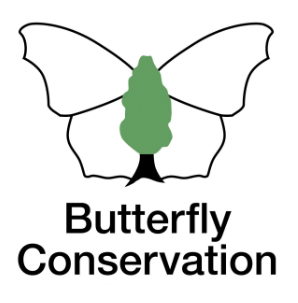Brown Argus
Brown Hairstreak
Chalkhill Blue
Clouded Yellow
Comma
Common Blue
Dark Green Fritillary
Dingy Skipper
Essex Skipper
Gatekeeper
Green Hairstreak
Green-veined White
Grizzled Skipper
Holly Blue
Large Skipper
Large White
Marbled White
Meadow Brown
Orange-tip
Painted Lady
Peacock
Purple Emperor
Purple Hairstreak
Red Admiral
Ringlet
Silver-washed Fritillary
Small Blue
Small Copper
Small Heath
Small Skipper
Small Tortoiseshell
Small White
Speckled Wood
Wall
White Admiral
White-letter Hairstreak
Extinct/rare immigrants
Large Skipper
Ochlodes sylvanus
General Distribution and Status
This species is widespread in England and Wales and is more common in the south. It also occurs in south-west Scotland. Numerous colonies were lost in the last century through farming intensification and the tidying up of the countryside. However, range and abundance have been relatively stable since the 1970s but with a significant decrease in abundance in the last ten years (Brereton et al.) and 2024 being one of the worst on record. In Hertfordshire and Middlesex, it became slightly more abundant than the 1990s (Wood, 2016), but a notable decline has occurred since 2015.
| United Kingdom | Herts & Middx | |||
| Distribution | 1976-2019 | -27% | 1980-2015 | -14% |
| Average 10-year trend | -6% | 2006-2015 | +30% | |
| 2024 since 2015-19 | -23% | |||
| Abundance | 1976-2024 | -30% | 1980-2015 | -14% |
| 2015-2024 | -37% | 2006-2015 | +35% | |
| 2023-2024 | -40% | 2024 since 2015-19 | -40% | |

UK distribution map
UKBMS Species summary
Habitat Requirements
Unimproved grassland, for example on roadside verges, woodland clearings, railway embankments and waste ground but it prefers shadier sites than the Small and Essex Skippers.
Larval Foodplants
Cocks-foot Dactylis glomerata is the preferred foodplant in the county (Sawford), but False Brome Brachypodium sylvaticum and Purple Moor-grass Molinia caerulea are also occasionally used.
Adult Food Sources
Common Bird's-foot Trefoil Lotus corniculatus (252), Bramble Rubus fruticosus agg. (69), Red Clover Trifolium pratense (39), Thistle Cirsium sp. (37).
Historical Records
Matthews noted the species at Norton Green Woods as highlighted in Gibbs' 1902 survey. Some reports published during the first half of the 20th century indicate that it was common and widespread. The 1934 Foster's report mentions it as being present. Rev. Greenham from Walkern saw it in nearby fields in around 1941 (Birdsall). Bowden notes that it was 'very numerous' on 2 June 1947 at Knebworth. Bell's 1973-76 report describes the butterfly as 'locally abundant'.
Local Distribution and Abundance
The butterfly is widely distributed in the Stevenage area as indicated on the map although it is apparently absent in several tetrads, notably TL22J (north Graveley) which is possibly due to lack of recorder effort. The area north of Graveley is mostly open farmland but there may be some sheltered spots near Roxley Court which might be suitable. There are no records for TL22C and TL22Y, areas predominantly agricultural, since before 2010, but there may still be suitable pockets of taller grassland. Numbers have been relatively stable in the last few years unlike the decline of the other golden skippers although 2024 saw a slight fall in numbers. In 2023, 79 individuals were counted during a Wider Countryside Butterfly Survey on 10 July - a record. The best sites are Fairlands Valley Park and Great Ashby Park. Like the Small and Essex Skippers, nectar sources are important for females to develop their eggs (Field et al.).

Stevenage (South Fairlands Valley Park) transect 1993-2025
Since the heights of 2009 the butterfly has endured a small decline in numbers in contrast to the rest of the county. Most specimens are now found on the edge of Monks Wood and Shackledell Grassland. Cuts in the last few years at Shackledell which removed many of the shrubs caused the reduction in numbers there. On 29 June 2003, I counted 65 specimens including 49 in one section, along the eastern edge of Whomerley Wood, the most abundant I have ever seen of the butterfly. In the best week in 2004, only nine were seen in this section because of overgrowth of shrubs but the cooler and cloudier weather in June was a factor too. Curiously, it has not suffered the same decline like the other golden skippers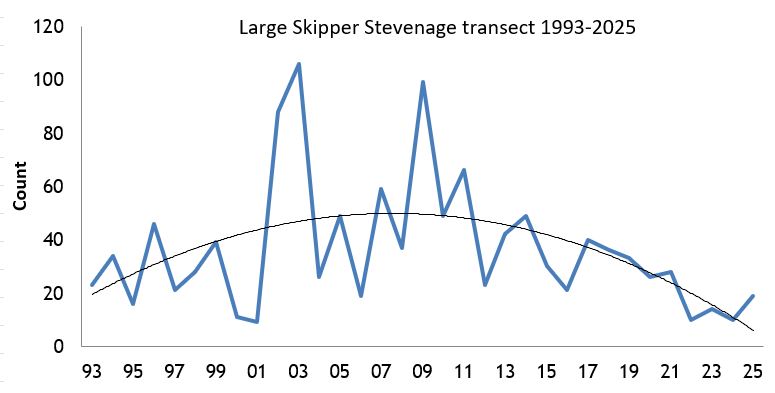
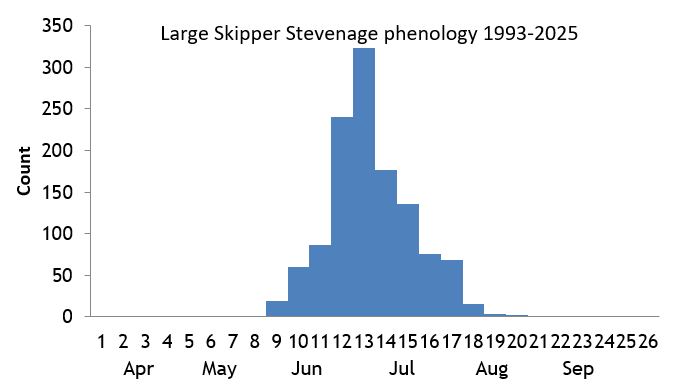
Knebworth Park transect 1996-2010 and 2017-2025
The latter half of the 2000s saw a notable decline in numbers and the downward trend is likely to be continuing with single-digit totals since the resumption of the transect in 2017. Note that in 2001 when the country was getting to grips with Foot and Mouth disease the transect was not walked until the second week in July, towards the end of the flight season for this species.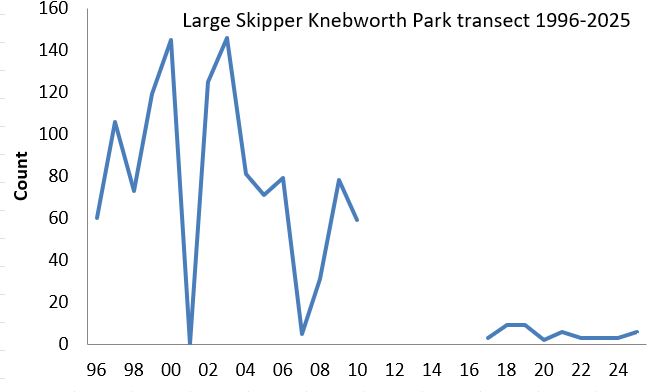

Knebworth Woods transect 2017-2025
A good pick-up in numbers in 2019 mostly down to more suitable habitat in the ride between The Firs and Newton Wood where coppicing of many trees was carried out during the previous two winters. 2020 and more so in 2021 also saw an increase probably because some parts of the meadow in Norton Green Common were left uncut. 14 specimens were counted on 26 June 2021, 12 of which were found in the meadow. A big drop in 2022 is probably a result of the prolonged drought in the spring and summer but there has been a recovery since then.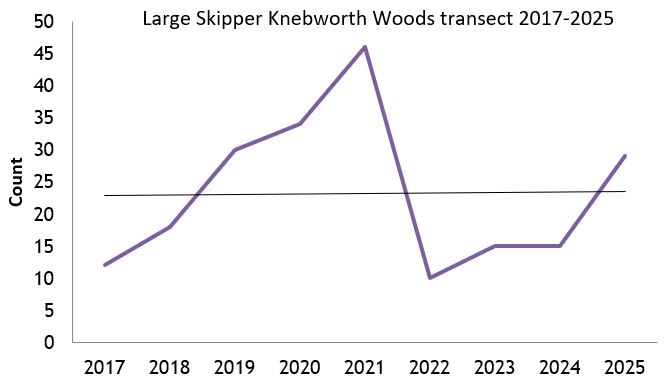
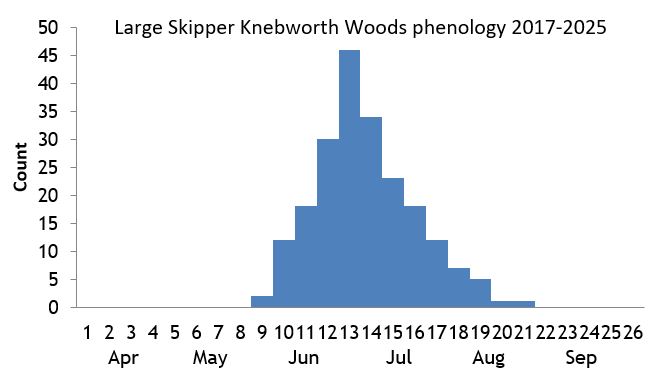
Pryor's Wood transect 2000-2022
Although numbers are fairly low populations do not indicate any significant trend. The best year was 2010 when nine specimens were recorded including four on 3 July. Seven individuals were seen on 3 July 2019.Life History
Earliest date: 16 May 2002 at GSK, Stevenage
Latest date: 28 August 2013 at Great Ashby Park
The butterfly generally emerges
in June with a long season lasting until the middle of August. The last week of June is the peak period as indicated on the chart. The eggs are laid beneath
leaf blades in sunny sheltered situations. Larvae hatch from the end of July to form tubes from several leaf blades and enter hibernation in this stage.
Pupae are formed within cocoons using silk, in late spring.
Behaviour/Observation notes
Like the Small and Essex Skipper, early mornings and evenings, or cloudy weather are good times to find this species resting or basking, offering opportunities to take close-up photographs. When the sun is shining, males in particular, are far more active.
Variations/Aberrations
One known specimen, that of a male, in Hertfordshire, ab. pallida, where wings are partly suffused with white, was found at Hertford Heath by
Sandra Standbridge in 2003 (Wood).
Find out more on the UK Butterflies website
References
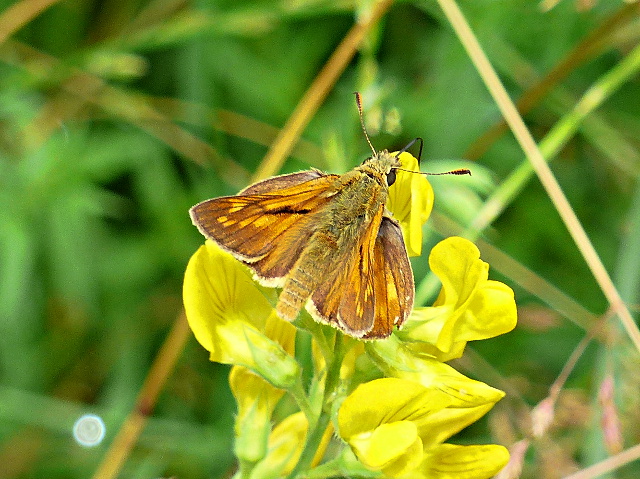
Shackledell 23 Jun 2016 (m)
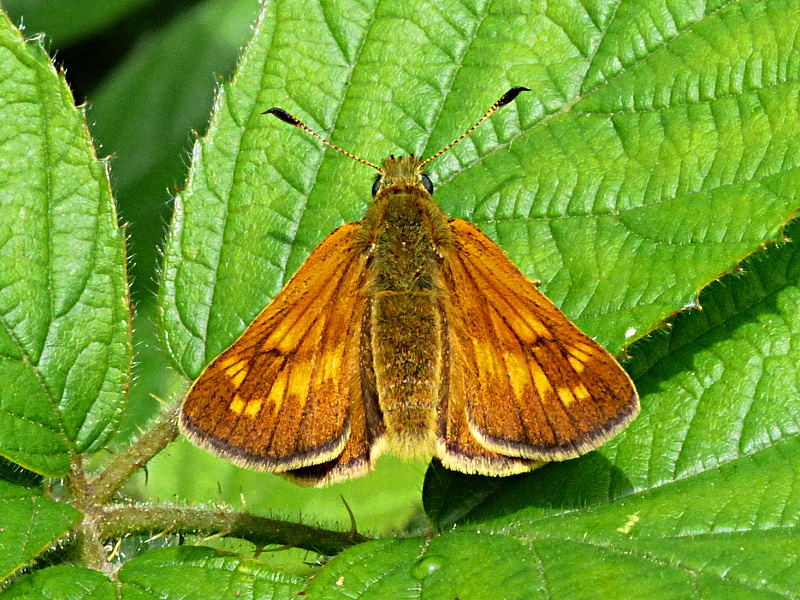
Watery Grove 18 Jun 2019 (f)
